Rigging
Rope and its uses
Rope of any kind can be described as belonging to one of two main types:
Cordage (which is made of vegetable or synthetic fibres).
Steel wire rope, or stainless-steel wire rope.
Fibre ropes are made up of fibres twisted into yarns, which are themselves twisted to form strands. Three strands laid up right-handed, that is, the strands running from left to right, form a hawser laid rope, which is the type of cordage commonly used. In a normal right-handed rope:
Fibres are spun right-handed to form yarns;
Yarns are twisted left-handed to form strands;
Strands are laid up right-handed into rope.
Because of this twist or lay of the rope, kinks and turns will form if the rope is coiled the wrong way. A right-handed rope must always be coiled down clockwise.
The length of a rope was measured in fathoms (one fathom feet), now it is measured in metres. The size of rope is measured by its diameter in millimetres.
A rope is kept in a coil or on a reel when not in use.
Rope will stretch under load and tend to twist in the opposite direction to that of its lay, but it should regain its normal form when slack.
Rope when wet will shrink in length and swell in diameter, but it will recover most of its original length when dry.
The golden rule for the care of rope is not to stow it away when wet, or it will rot. Rot and damage are detected by opening a strand.
Types of ropes commonly used are made of:
Manila: a new manila rope is golden brown in colour and is used for boat’s falls and important lifting gear.
Sisal: A hairy pale straw colour rope, used for general purposes. Sometimes treated with tar to protect it from the weather.
Hemp: Also, a pale straw colour but is hard and smooth in texture. Often found in small lines such as cod-line.
Coir, or Grass Line: A very rough coconut brown colour. Lighter and weaker than the others but more resilient and is useful because it will float
Sometimes rope is made up with a coloured yarn called a rogue’s yarn running through its length. This denotes its point of manufacture
Synthetic Ropes
In small boating today synthetic ropes have almost completely replaced natural fibre ropes. The main advantages of synthetic ropes are:
Greater strength for lighter weight. More than twice as strong as manila.
Absorb very little water.
Pliable and easy to handle even when wet.
Higher resistance to exposure, to weather.
Will not rot, mildew or deteriorate even if put away wet.
Twisted or braided types available. Braided ropes though not as strong as twisted are softer on the hands and less likely to kink, they cannot however be spliced.
The three main types of synthetic rope are:
Nylon, which has the greatest strength and because of its elasticity can absorb shocks. It will stretch up to 40% before breaking.
Warning: Because of this, keep crew away from nylon under strain. A break or failure of a fitting will result in back lash. Suitable for use as anchor ropes, tow ropes, mooring lines.
Terelene, a little heavier than nylon and not quite as strong. It has about one-half the stretch of nylon and is therefore used where this is important such as in halyards. Its high resistance to abrasion also makes it suitable for mooring lines.
Polypropylene (Ulstrom) has most of the qualities of nylon and terylene, with slightly less strength and small stretch, and is cheaper. Its main characteristic is that it floats on water. This makes it unsuitable for anchor ropes, but very useful for painters and heaving lines. It is usually yellow in colour.
Spun polypropylene braided ropes are the best for sheets. They are soft on the hands and will not kink. The ends have to be tied or eyes seized into them as these ropes cannot be spliced.
Bends and Hitches
The Sea Scout is already familiar with many knots described in N.Z. Scout Handbooks, and those covered here are additional useful bends and hitches used by seamen.
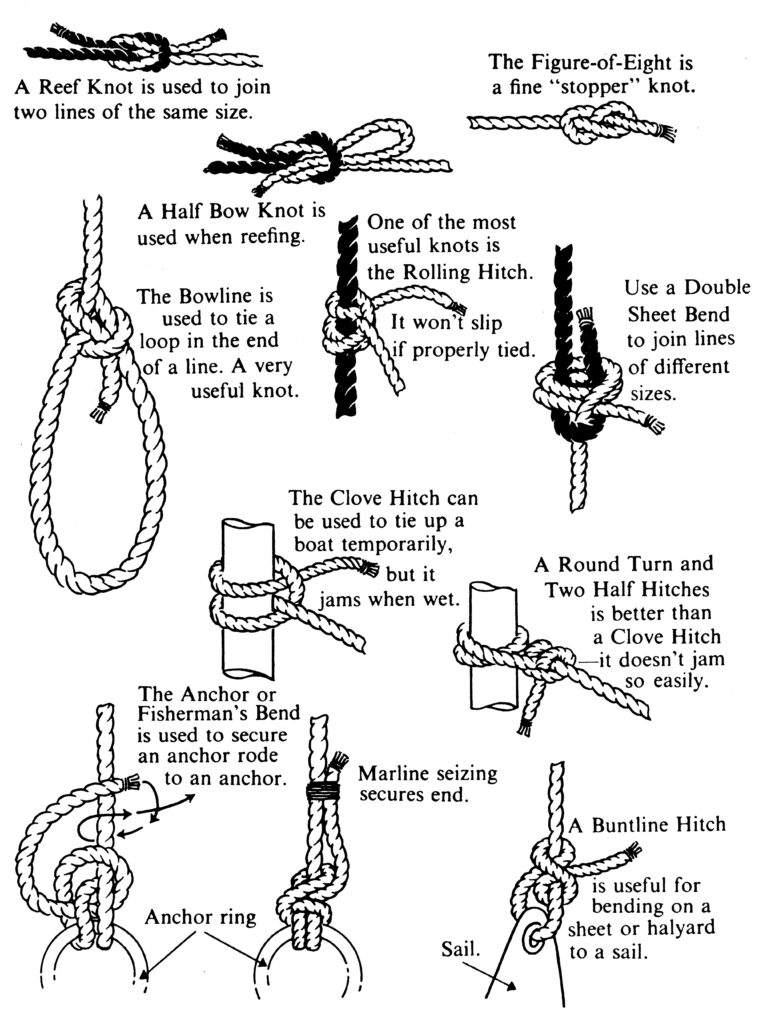
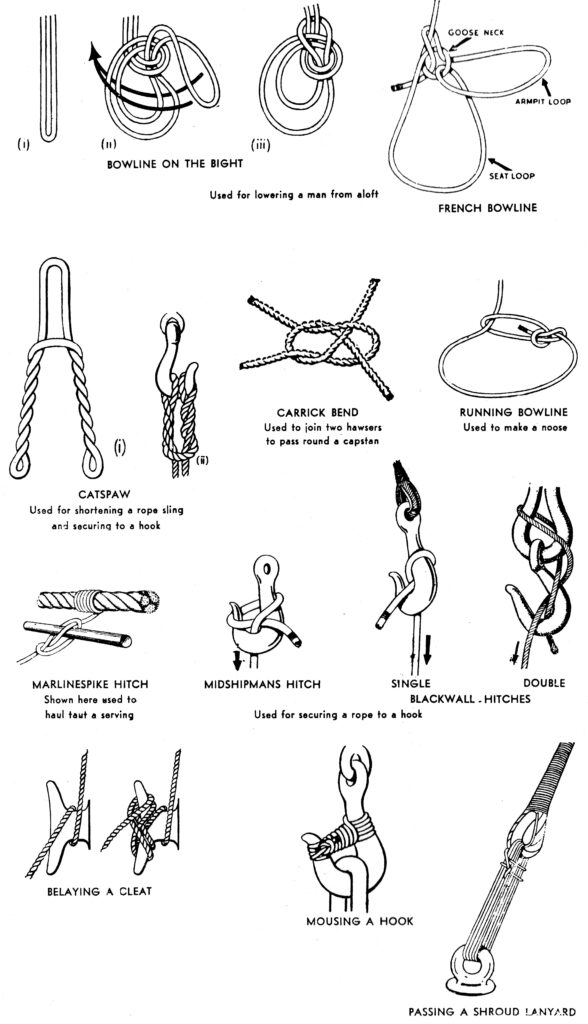
TURK’S HEAD
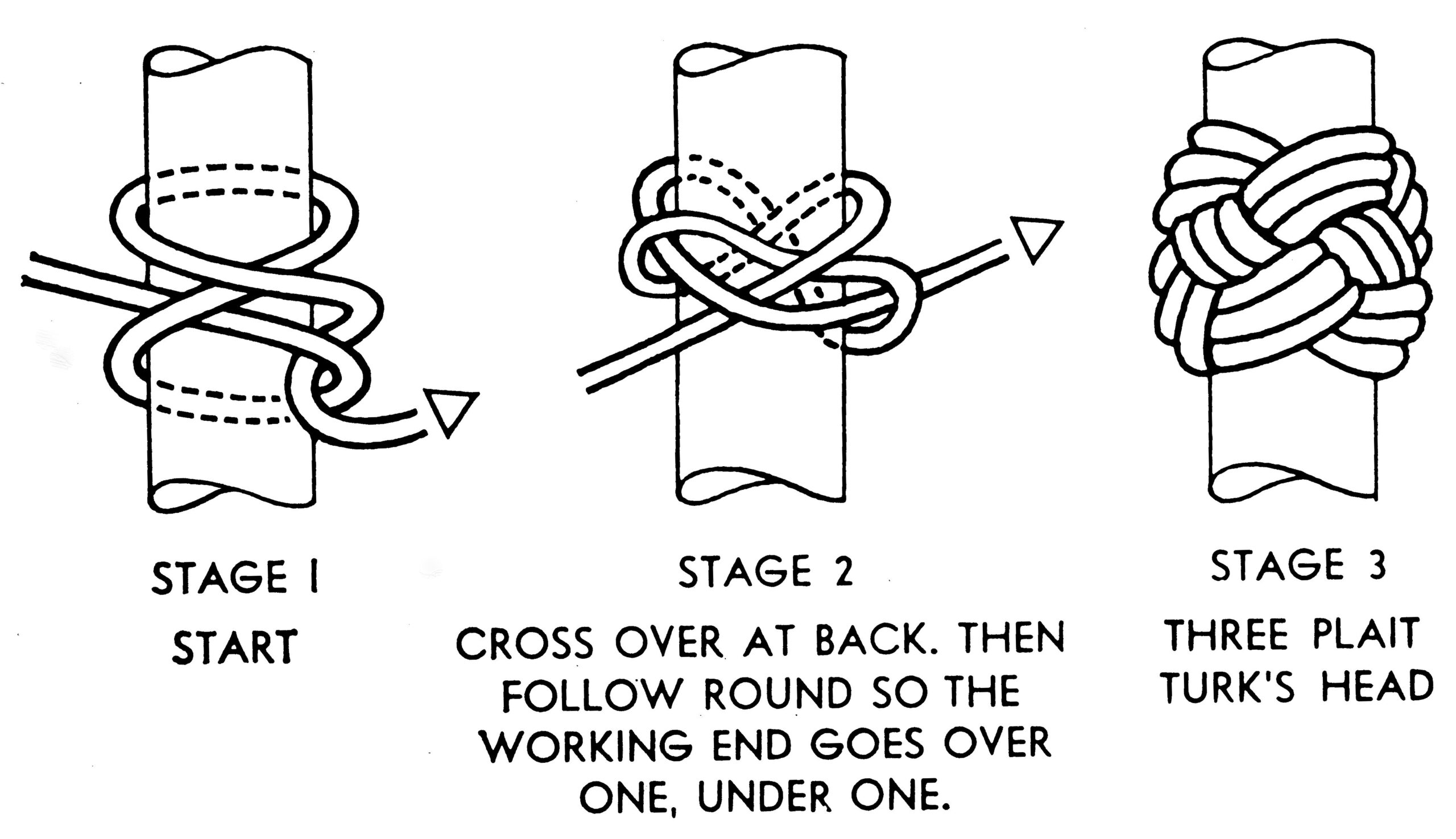
Whipping
Whenever a rope is cut the ends will tend to unlay, and to prevent this the ends must be whipped. Even the Recruit Sea Scout knows how to make a common whipping, but ropes for use in the boat should be whipped with the more permanent sailmaker’s whipping. The back-splice can also be used for this purpose, but as this splice increases the circumference of the rope it will not pass through a block of the appropriate size and is therefore never used on sheets and halyards. An unwhipped rope end is a sure mark of the landlubber.
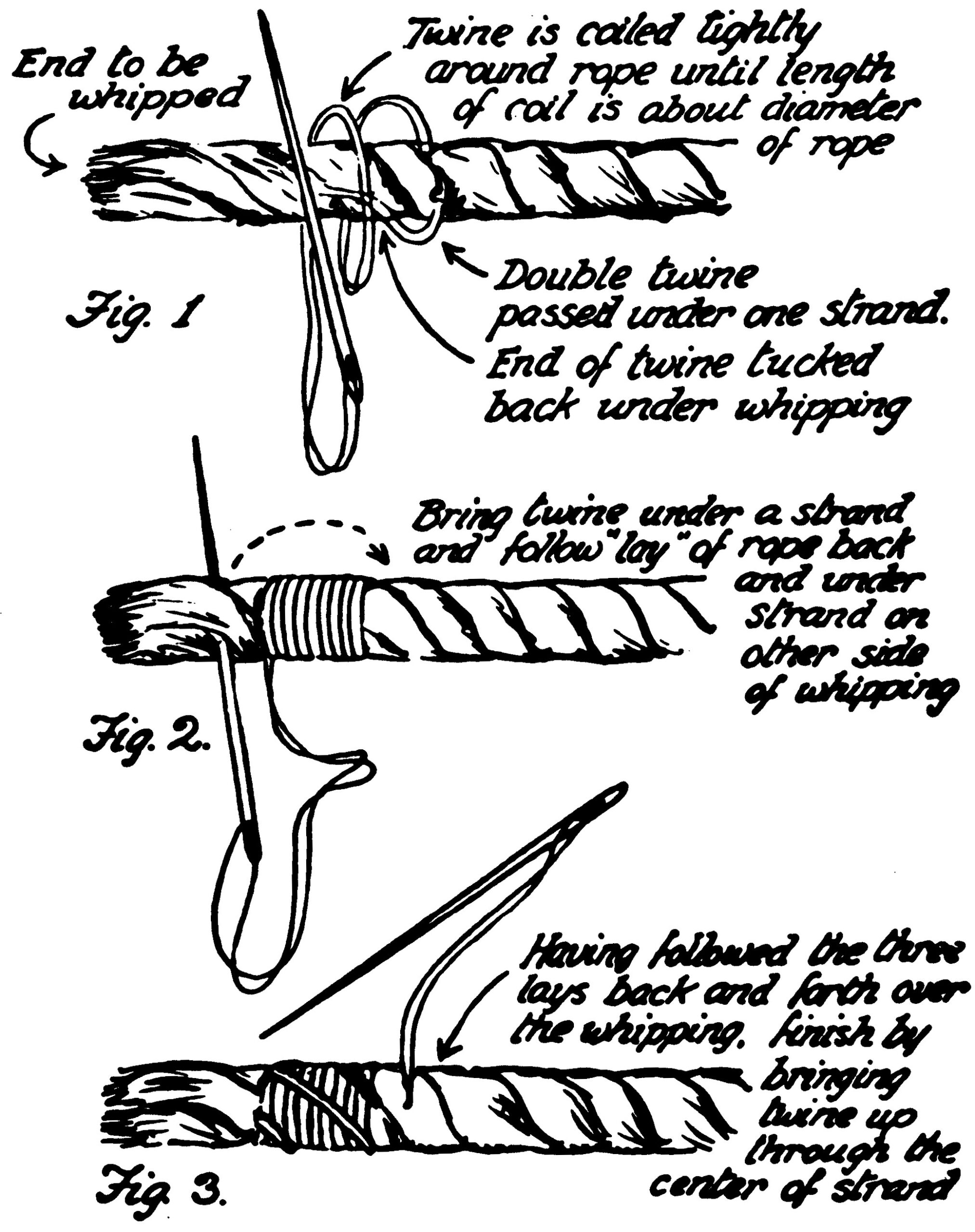
Splicing
Splicing is a method of joining the ends of two ropes together or of making an eye in the end of a rope, by interlocking the strands. The principal splices a Sea Scout should be able to make are:
Eye Splice
Unlay the rope for a sufficient distance from the end according to the size of eye required and the size of the rope.
- Tuck the centre strand through the upper most strand of the rope at the size of the eye required.
- Take the left-hand strand and tuck it to the left under the next strand.
- Turn the splice over and tuck the third strand under the remaining strand from right to left. Then, starting with strand No. 3, haul each strand taut evenly.
- Now tuck all three strands a second and third time.
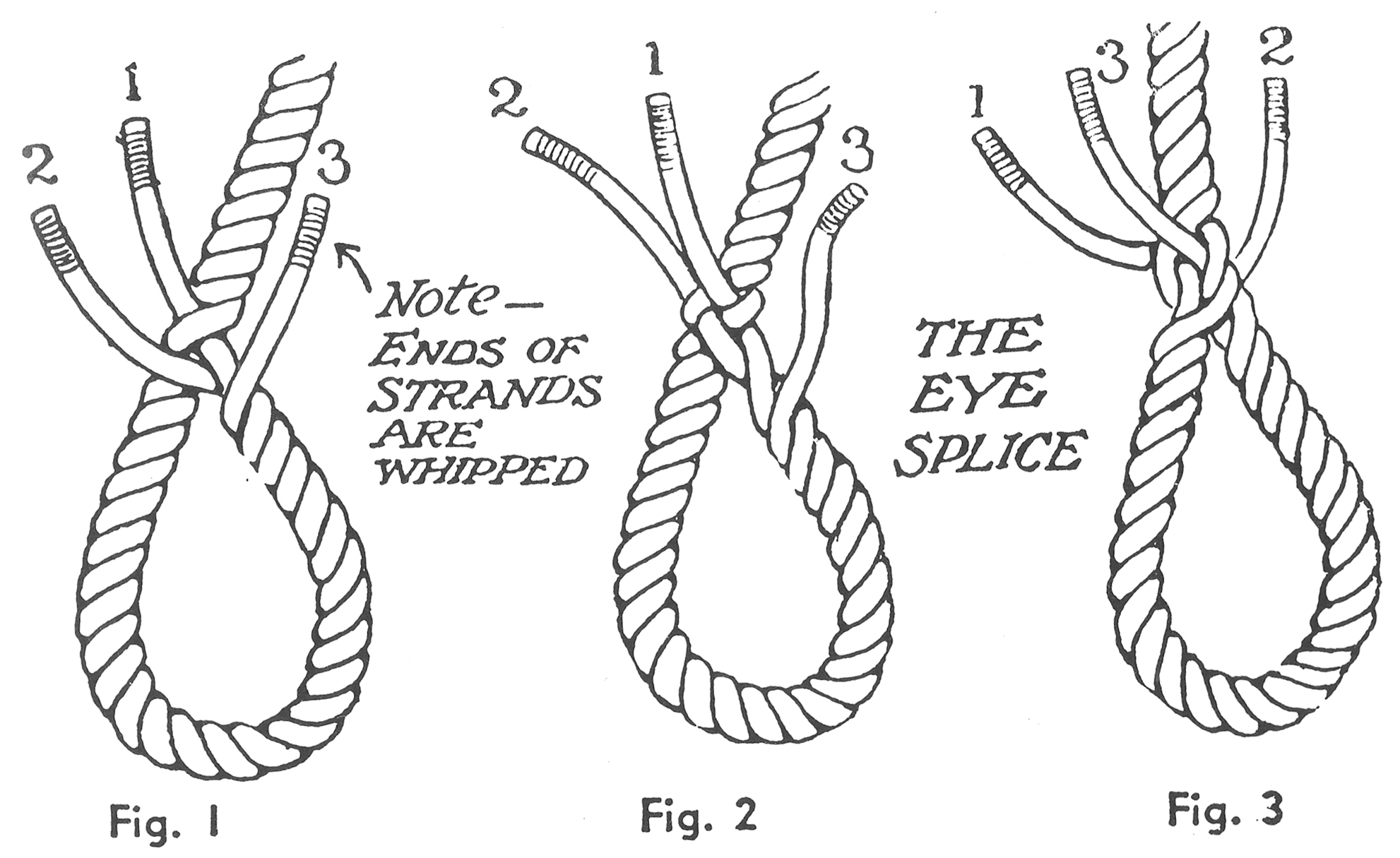
Backsplice
Used to finish off the end of a rope not required to run through a block.
- Unlaying the strands.
- Making the crown knot, “crowning the rope”.
- Crown pulled taut.
- Making the first tuck. Note: Always across the lay.
- First tuck completed.
- The finished splice.
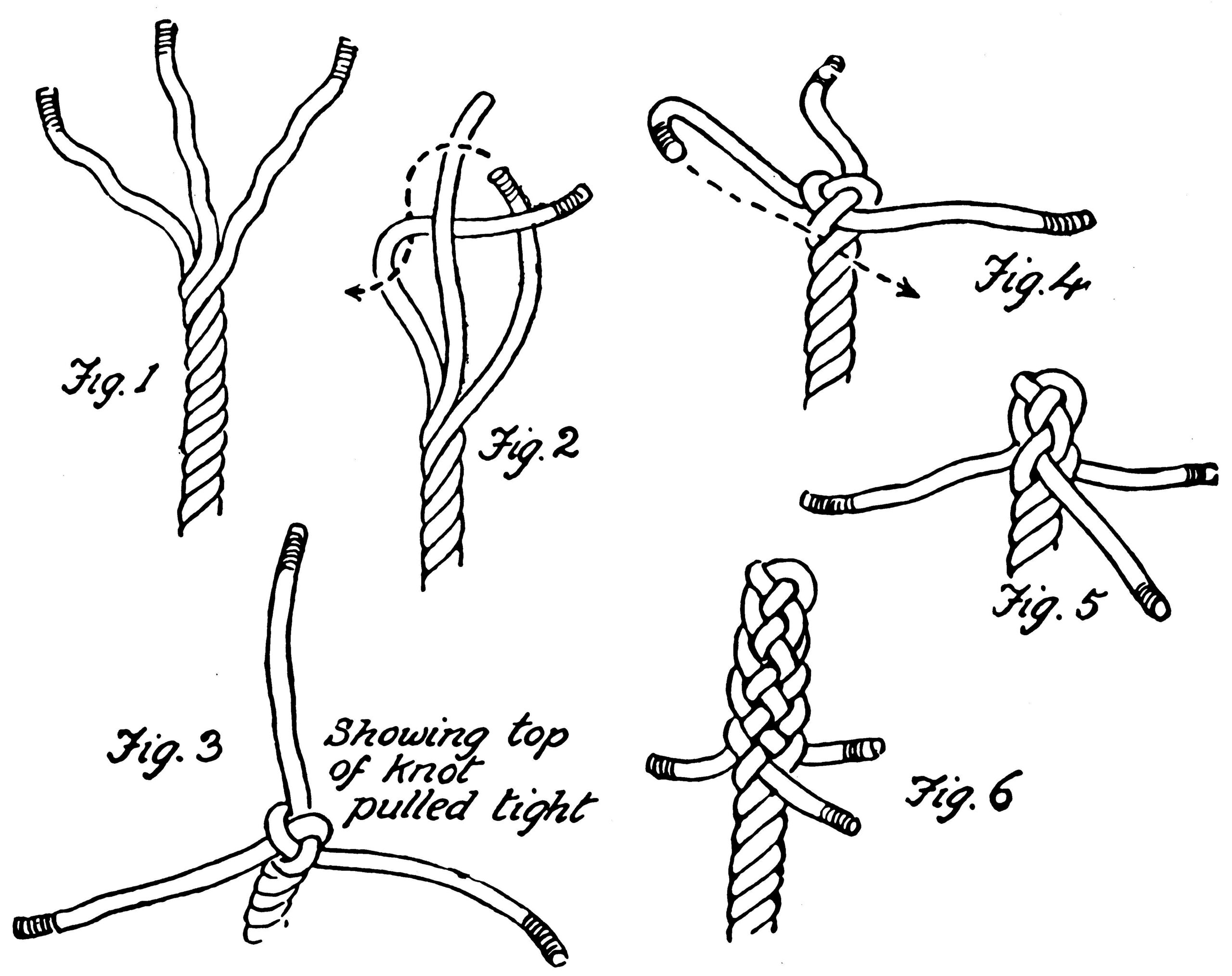
Short Splice
Used for joining two ropes which do not have to pass through block because the finished splice will slightly increase the size of the rope.
- Unlay the rope, as for an eye splice, and put a stop on to prevent further unlaying.
- “Marry” the ropes together.
- Hold down the ends on one side of the splice against the rope, while tucking the other ends, as in an eye splice, over and under from right to left.
- Having tucked one side, tuck the remaining ends the other side. Then tuck all strands a second and third time.
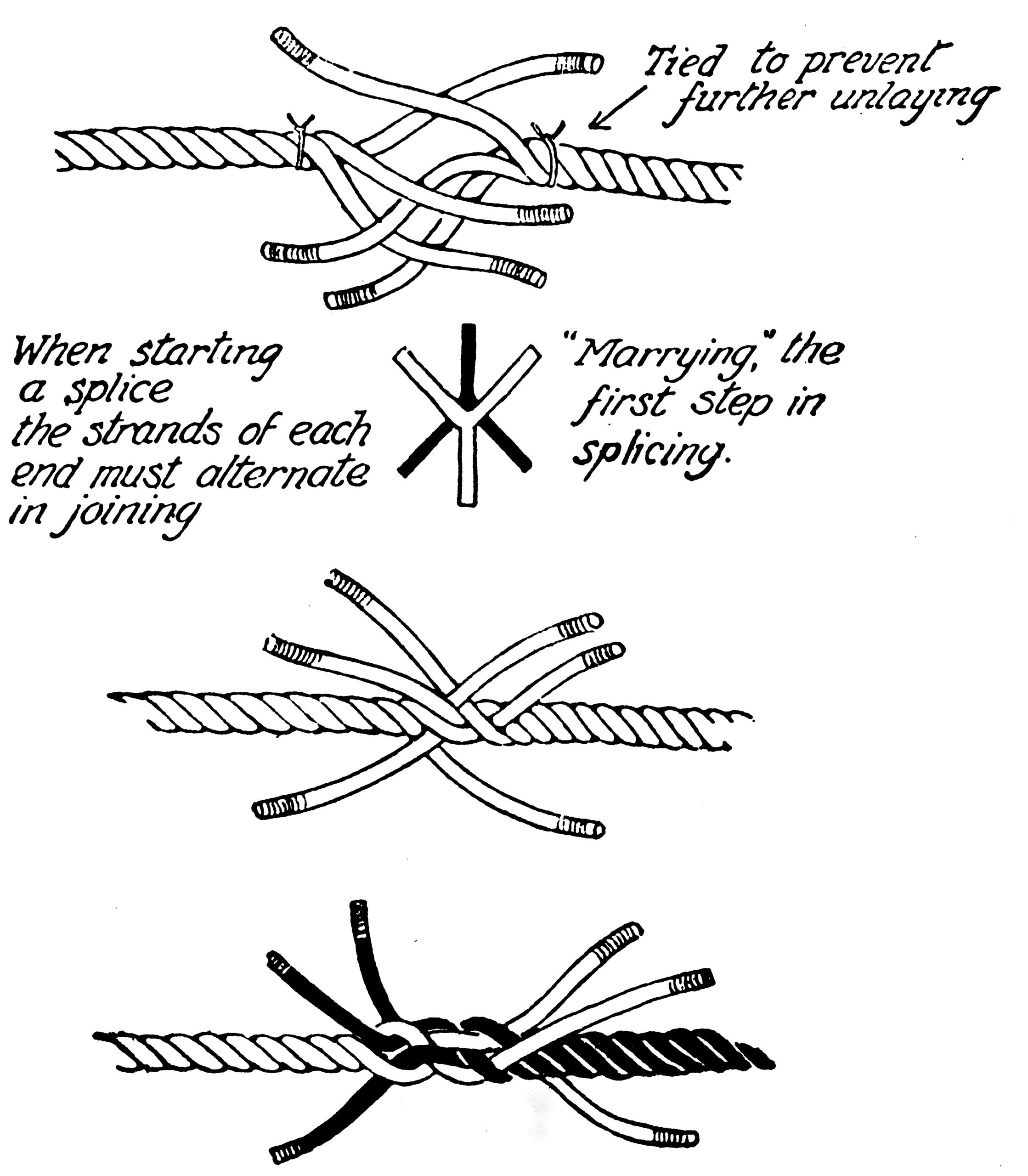
Long Splice
This splice is used to join two ropes together when they are required to pass through a block, and if well made it does not increase the circumference of the rope.
- Unlay the strands for at least six times the circumference of the rope.
- Marry the strands as for the short splice.
- Unlay strand 1A and lay up strand 2A in its place.
- Unlay strand 2B and lay up strand 1B in its place.
- Halve each strand and tie together with an overhand knot.
- Tuck all ends at least once, as shown for strand 1 B in the diagram, and then cut off.
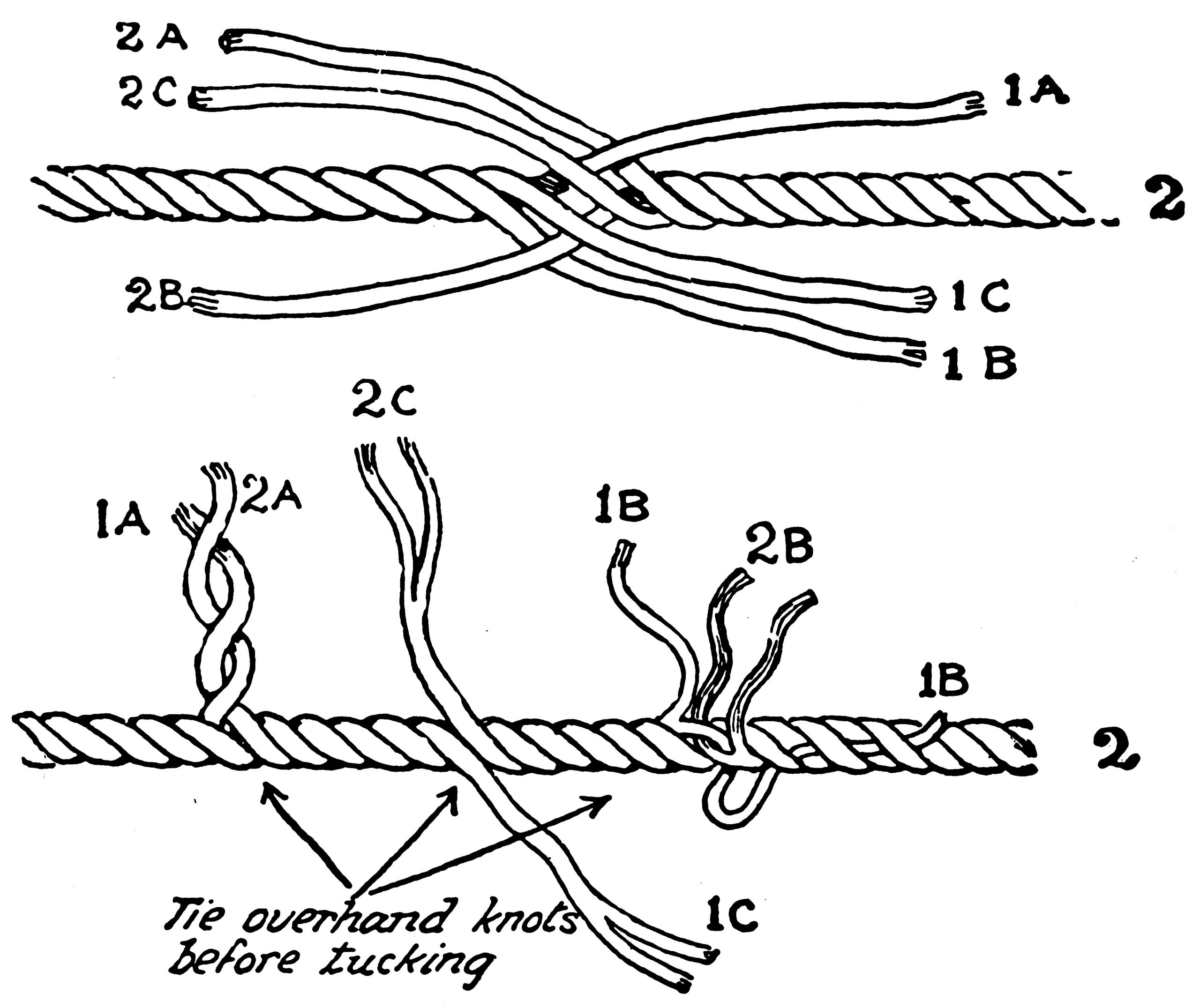 Wire Rope (not stainless steel)
Wire Rope (not stainless steel)
Wire rope is constructed of a number of small wires which extend throughout its length. These wires are twisted left-handed round a jute or wire core and the six strands forming the rope are laid up right-handed around a hemp or jute heart. This heart has two functions:
It acts as a cushion into which the strands bed, allowing them to take up a natural position as the rope is bent or subjected to strain.
It absorbs the boiled linseed oil or other lubricant with which the rope should periodically be dressed, so that as the rope is stretched or flexed the oil is squeezed between the wires, thus lubricating them and minimising any friction between them.
Steel wire rope used for standing rigging is not required to be flexible and its strands are made of a small number of large gauge wires round a steel wire core (six strands each of seven wires). Flexible steel wire rope as used in running rigging and hawsers consists of a number of medium gauge wires wound round a large jute core (six strands of 12 to 30 wires).
The length of wire rope is measured in metres. Its size is measured in the Navy by its circumference and in the Merchant Service by its diameter across its largest diameter.
Wire rope should be kept on a reel when not in use.
If wire rope is to be cut the ends must first be whipped on both sides of where the cut is to be, then placed on a vice or similar hard surface and cut with a hammer and cold-chisel or wire cutters.
Stainless steel wire is more often used for the rigging of small craft being much stronger. It cannot be spliced and is fastened round thimbles with bulldog grips or talurit splices which are machine made and won’t draw as the metal splice is forced right into the parts of wire.
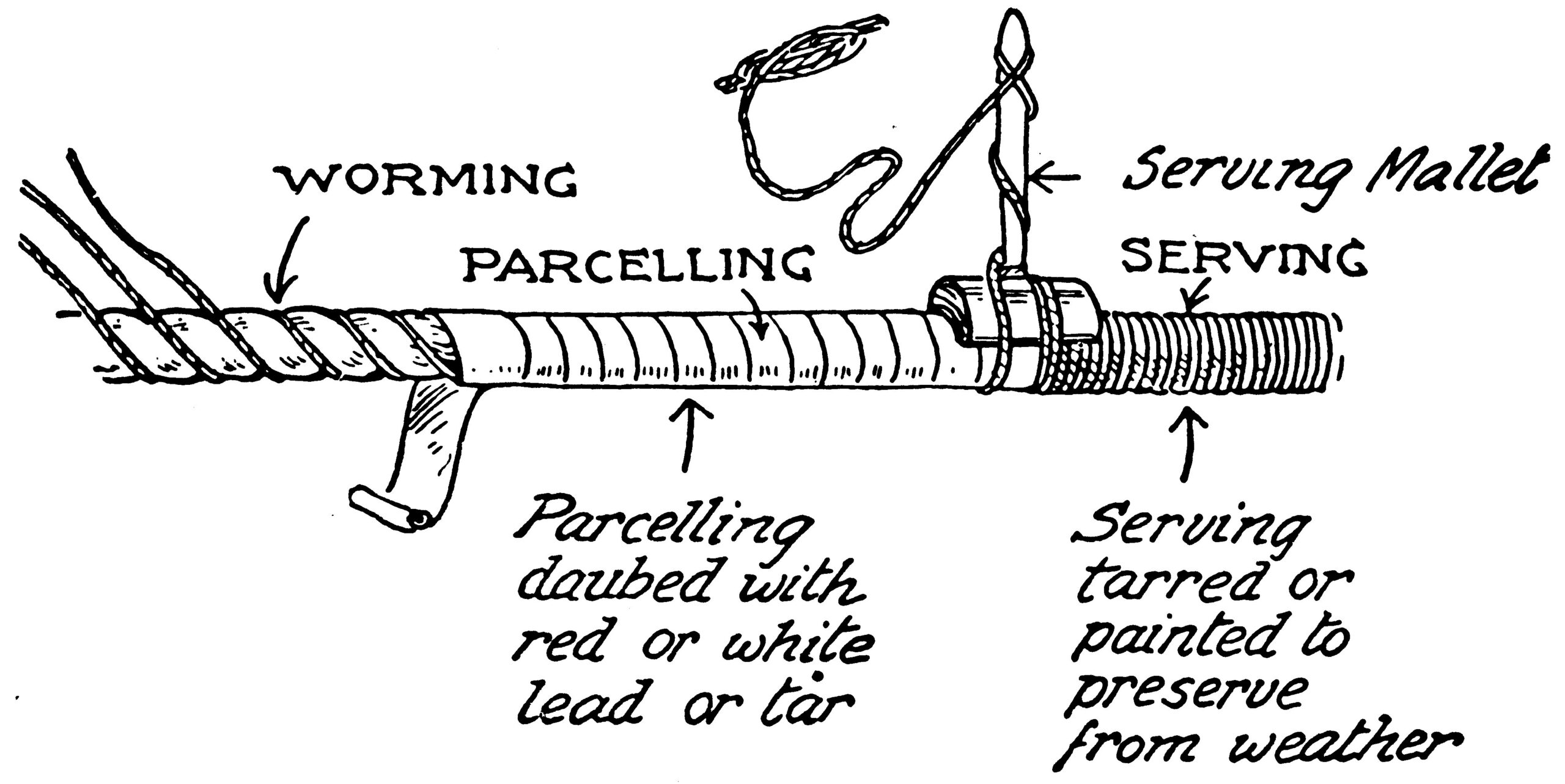
Shrouds made from ordinary wire rope have hard eyes spliced in either end, and these are “served” to protect them from the weather and also, in the case of small craft, to prevent the crew from being “snagged” by the wire ends in the splice.
Worm and parcel with the lay,
Turn and serve the other way,
used to be the old rhyme about the covering of ropes.
Worming was the laying of a small line in the score between the lay of the ropes and parcelling the wrapping of the rope with strips of canvas. The whole lot was then “served” against the lay of the rope with tarred twine wrapped taut round using a serving mallet.
For small wires, such as Standard boat shrouds, it is not necessary to worm and parcel first. However, before making the eye-splice in the wire, serve that part of the wire which is to be the crown of the splice first, then insert the thimble and stop the wire temporarily to the thimble before commencing the splice. When the splice is completed serve over it toward the neck of the thimble.
There are two or three ways of making an eye splice in wire and full descriptions of how to proceed are given in Vol. II of the Seamanship Manual and in the Boatswain’s Manual by Captain William A. McLeod. If the Skipper can arrange for a seamanship instructor to demonstrate, so much the better. Wire splicing is becoming a dying art due to the use of stainless-steel wire.
Blocks and Tackles
A block is so named because it was originally a block of wood with a hole in it for a rope to reeve through. To reduce friction the hole was enlarged to take a pulley-wheel or sheave. Then the surplus wood was cut away from the outside of the block, leaving a wooden shell. This was grooved, called the score, to take a rope spliced round the block to secure it in place as required. If the wooden shell split the block was useless, so the next step was the “iron-bound block” in which the strop or hook was riveted to an iron case carrying the sheeve and its pin, the wooden shell acting as a fairing piece. Today the larger modern blocks are made of metal, and friction is further reduced by roller bearings between the sheave and its pin.
Wooden blocks are classified by their size, which is the length from crown to tail measured round the shell; an ordinary wooden block will take a rope one-third its size, so that a 225 mm block, for example, will take a 75 mm rope. Metal blocks are classified by the size of rope for which they are designed, and this is usually marked on a plate affixed to one cheek. The small, galvanised iron blocks or stainless steel with nylon bush used in the running rigging of the Standard boat are sold by the chandlers as “awning pulleys”. Blocks are described as single, double or treble, depending on the number of sheaves they have.
A tackle (pronounced tayckle) is a portable purchase consisting of a rope rove through two or more blocks in such a way that any pull applied to its hauling part is multiplied by an amount depending upon the number of sheaves in the blocks and the manner in which the rope is rove through them.
The blocks of a tackle are termed the standing block and the moving block and the rope rove through them called the fall.
The amount by which the pull on the hauling part is multiplied by the tackle is called the mechanical advantage, and, if friction is disregarded, is equal to the number of parts of the fall at the moving block.
The number of parts at the moving block, and therefore the mechanical advantage, is always greater when the hauling part comes away from the moving block, and such a tackle is said to be rove to advantage. Conversely, a tackle in which the hauling part comes away from the standing block is said to rove to disadvantage.
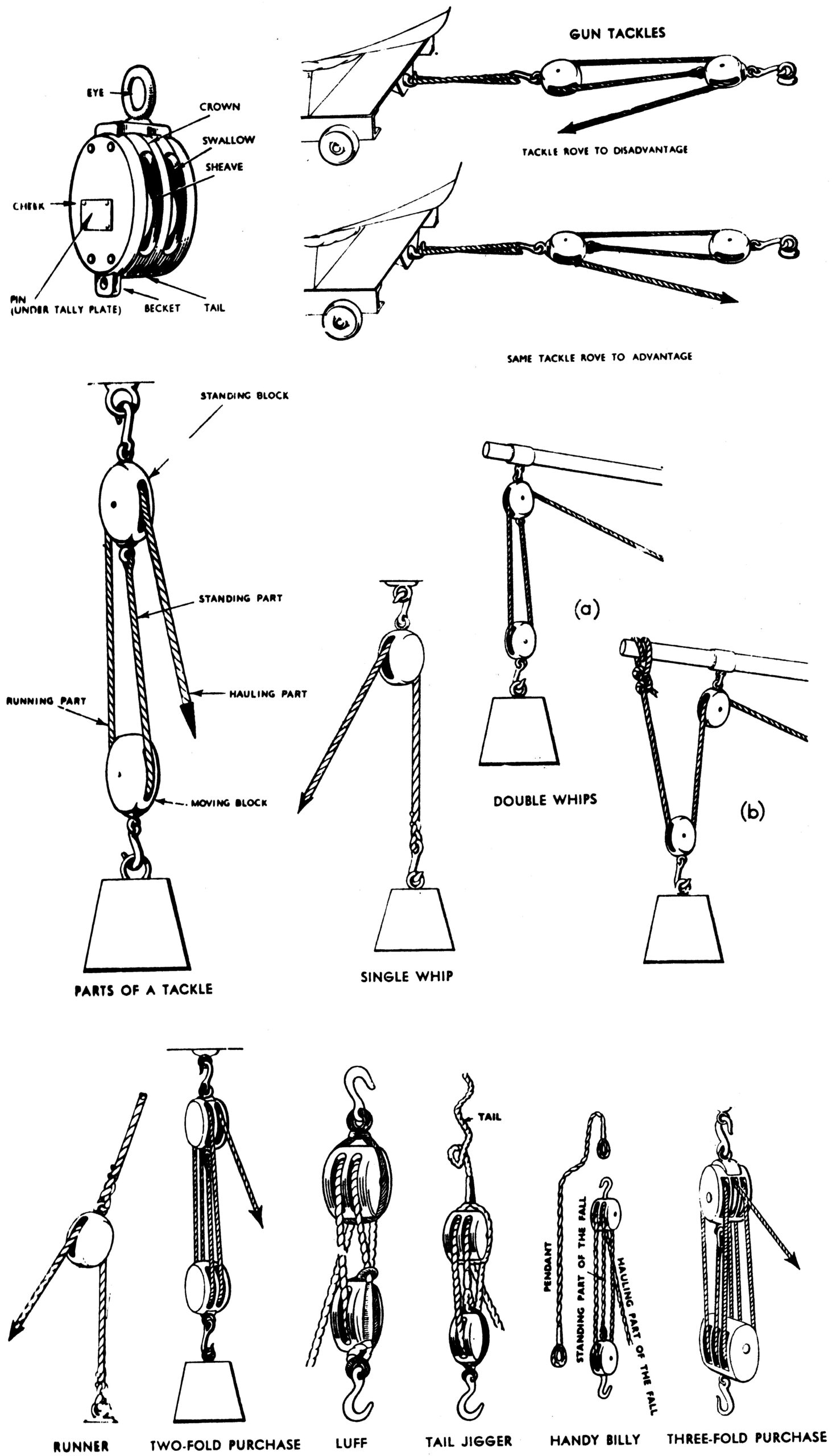
Examples of Tackles
A single whip is a fall rove through a single standing block. No mechanical advantage is gained. Used for hoisting light loads.
A runner consists of a rope rove through single moving block. As there are two parts of the fall in the moving block, the mechanical advantage is two.
A double whip is the simplest form of purchase where a fall is rove through two single blocks, the standing part being secured to the upper block. Mechanical advantage is two. Used for hoisting. The mainsheet of a Standard boat is a double whip. The gun tackle is also a term applied to purchase of two single blocks, but which is not used for hoisting. The name originates from the small tackle which was used to run out the old muzzleloading guns after they had recoiled. Mechanical advantage is three if rove to advantage or two if rove to disadvantage.
A luff is a purchase of 75 mm in size or greater. It consists of a double and single block with the standing part of the fall made fast to the single block. Mechanical advantage is three or four.
A jigger is similar to a luff but about 50 mm in size, fitted either with hook blocks or with a tail on the double block instead of a hook (tail jigger). The standing part of the fall is spliced to the strop of the single block.
A handy billy is a small tackle of less than 50 mm for general purposes. It is usually rove as a jigger, but the name can also apply to a small gun tackle.
Two-fold purchase consists of two double blocks and commonly used for hoisting boats. Mechanical advantage four or five.
Three-fold purchase consists of two treble blocks. Mechanical advantage six or seven.
To overhaul a tackle is to separate the two blocks further.
To round up a tackle is to move the two blocks closer together by hauling on the fall. Opposite to overhaul.
A tackle is said to be two blocks when both blocks are hauled up together and touching.